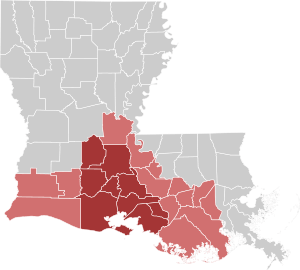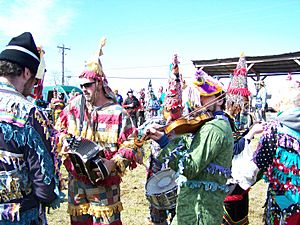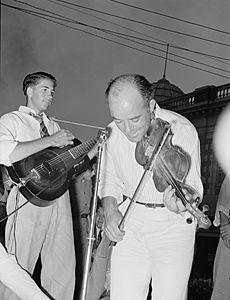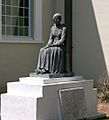Cajuns facts for kids
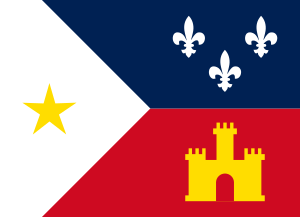 |
|
| Total population | |
|---|---|
| 1.2 million (2002 estimate) | |
| Regions with significant populations | |
| 815,259 | |
| 546,354 | |
| Languages | |
| French (Louisiana French) English (Cajun English) Louisiana Creole |
|
| Religion | |
| Christianity: Predominantly Roman Catholicism | |
| Related ethnic groups | |
| Acadians, Métis, Atakapa, Choctaw, Chitimacha, French, French Americans, French Canadians, Spaniards, Isleño, Spanish Americans, Québécois, Louisiana Creoles, French Haitians | |
The Cajuns are a special group of people who mostly live in the U.S. state of Louisiana. Many Cajuns are descendants of French-speaking people called Acadians. These Acadians came from a place called Acadia, which is now part of Eastern Canada.
Long ago, in the 1700s, the Acadians had to leave their homes during a big conflict between France and Britain. This event is known as the Great Expulsion. They traveled a long way and eventually settled in Louisiana.
Over time, the Acadians in Louisiana developed their own unique culture. They are known for their special way of speaking French, called Louisiana French, and their lively music and delicious food. The area in Louisiana where many Cajuns live is called Acadiana.
Contents
Cajun Culture
Cajun culture is rich and full of traditions. It includes their unique way of life, music, food, language, and religious customs.
Where Cajuns Live
Most Cajuns live in the Acadiana region of Louisiana. This area is often called the "Cajun heartland." You can also find Cajun communities in other parts of Louisiana, like southwest of New Orleans, and even in parts of Southern Mississippi.
Many Cajuns and Creoles also moved to cities in Southeast Texas, like Houston and Beaumont. They often moved there for jobs in the oil industry in the 1970s and 1980s. However, the city of Lafayette is known as "The Heart of Acadiana" because it's a major center for Cajun culture.
Cajun Music
Cajun music grew from the songs of French-speaking people in Canada. In the past, the fiddle was the most important instrument. But now, the accordion is just as popular. Cajun music became famous across the country when the Grammy Award for Best Zydeco or Cajun Music Album category was created in 2007.
Cajun Food
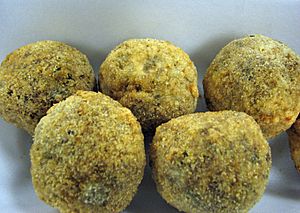
When the Acadians arrived in Louisiana, they learned from the local Creole and Native American people. They started using local ingredients like wild game (like duck and rabbit), vegetables (like okra), and grains. People living near the coast also ate a lot of fish and shellfish. Seafood is still very popular in Cajun cooking. You'll find it in classic dishes like seafood gumbo and court boullion.
Cajuns were often farmers and didn't waste anything. Many rural communities had a weekly boucherie. This was a community event where people would butcher an animal, often a pig, and share the meat. Popular Cajun foods like cracklins (crispy pork rinds) and boudin (a type of sausage) came from this tradition of using every part of the animal.
Cajun Language
The French spoken by Cajuns is often called "Cajun French." It's a special dialect of the French language. In the past, there were many different ways of speaking French across the Cajun region.
Younger Cajuns often speak Cajun English. This is a type of English that has been influenced by French words and sounds. Older Cajuns might speak it as a second language.
Religious Traditions
"Our Lady of the Assumption" is a special patron saint for Acadians and Cajuns. In 1638, the Pope and the King of France dedicated France and its colonies, including Acadia, to Mary under this title. The date of this dedication, August 15, is an important day for Roman Catholics.
Traditional Catholic celebrations are very important in many Cajun communities. These include Mardi Gras, Lent, and Holy Week. These customs are a big part of how Catholicism is practiced in Cajun-Creole Louisiana.
Mardi Gras
Mardi Gras means "Fat Tuesday" in French. It's the day before Ash Wednesday, which starts Lent. Lent is a 40-day period of fasting and reflection before Easter Sunday. Mardi Gras was traditionally a time to eat rich foods like fat, eggs, and meat before Lent began.
Cajun Mardi Gras celebrations in the countryside are different from the big parades in New Orleans. A special part of the Cajun celebration is the Courir de Mardi Gras, which means "Fat Tuesday run." A group of people, often on horseback and wearing special hats and costumes, visit farmhouses. They ask for ingredients for a community gumbo pot. Sometimes, the farmer lets them catch a chicken! The group puts on a funny show, trying to catch the chicken. They sing songs, tell jokes, and act out skits. The chicken is then added to the gumbo pot at the end of the day. The courir in the small town of Mamou is very famous.
Easter
On Pâques (French for Easter), Cajuns used to play a game called pâquer or pâque-pâque. Players chose hard-boiled eggs and tapped them together. The person whose egg didn't crack was the winner. This is an old European tradition that has continued in Acadiana. Today, Cajuns still play paque, but they also celebrate Easter like other Christians in the United States, with candy baskets, the "Easter bunny" and dyed eggs and hunts.
Cajun Folk Beliefs
Some Cajuns believe in a traiteur, or healer. This person uses prayer and touch to help with different sicknesses, like earaches or warts. Another belief is in the rougarou, which is like a werewolf. Stories say the rougarou hunts people who don't follow the rules of Lent. In some places, the rougarou is even seen as a protector. Children are told that loups garous (another name for rougarou) can see into souls and only hunt bad people.
Celebrations and Gatherings
Cajuns and other people in Cajun Country are known for their joie de vivre, which means "joy of living." They believe in working hard and also in "letting the good times roll" (laissez les bon temps rouler).
Community Help
In Cajun culture, a coup de main (meaning "to give a hand") is when the community comes together to help someone with a big or difficult task. This could be helping to build a barn, gather crops, or assist older or sick neighbors.
Festivals
Most Cajun festivals include a fais do-do or a street dance with live local bands. A fais do-do originally meant "go to sleep" in French. It came from parents telling their children to sleep in the dance hall rafters while they danced late into the night. These festivals can attract thousands of people.
Images for kids
-
The Acadian Country in 1754
-
Acadian militia captain Joseph "Beausoleil" Broussard
-
The deportation of the Acadians.
-
Filipino-Cajuns of Saint Malo, Louisiana
-
Singer Beyoncé is of Cajun Creole heritage
-
Louisiana's Cajun governor, Edwin Edwards
-
A statue of Evangeline—fictional heroine of the poem Evangeline by Longfellow—at St. Martinville, Louisiana. The statue was donated by actress Dolores del Río, who also posed for it. In a 1929 silent film by director Edwin Carewe, del Rio portrayed Evangeline.
See also
 In Spanish: Cajún para niños
In Spanish: Cajún para niños


